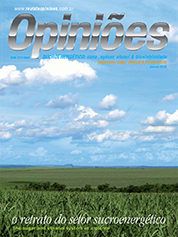Maurílio Biagi Filho
President of Maubisa - Maurilio Biagi Consultoria & Negócios
Op-AA-25
The globalization of ethanol
One of the most affected by the global financial crisis, the sugar and ethanol industry experienced much turbu-lence in the past 24 months, but one cannot ignore that the outlook is still very good – perhaps even better than before, if we take into account the intensity of climate change and increased global competition.
If it were not the most competitive in the world, our sugarcane agro industry would not have attracted some of the world’s largest investors, whose strategic vision should be a lesson for all of us who monitor the ups and downs of the industry, in the course of the last few decades. When the Proálcool program was created in 1975, analysts and researchers of several countries visited Brazil and most of them questioned the program rather than praised it.
For many, many years, one argued that sugarcane plantations would expand occupying food plantations. After more than three decades, sugarcane occupies almost 9 million hectares, more than 200% above the 1975 level. With its expansion based mainly on the occupation of grazing lands (rather than land used for grain plantations), the sugarcane agro industry produces sugar and ethanol at the lowest cost worldwide.
In the same period, agriculture and cattle breeding in Brazil increased production at an astonishing rate, stabilizing the domestic food supply and bringing about a major leap in the country’s trade balance. In both sugarcane plantations and the production of sugar and ethanol we are so efficient that we could actually relax, just like the rabbit in the fable about its race against the turtle.
That is where the danger lies. In 2011, for the first time after 10 years of uninterrupted growth, the production of sugarcane will be smaller than in the previous season. A good point in time to objectively assess the situation, now that about half the sugarcane processing is in the hands of large global players in the food and energy commodity markets.
Such companies do a lot of surveying before they enter a new industry. Their decisions are technical. Before investing in the Guarani mill, the French company Tereos, over a period of five years, took its cooperative partners on tours to several countries. A similar decision-making process took place at ADM, Cargill, Dreyfus, Odebrecht, Petrobras, Shell and even Cosan, whose origins lie in sugarcane.
An executive of the caliber of Pedro Parente would not accept to be in command at Bunge if he did not agree with the company’s long term business plan. For all these reasons, there is no doubt in my mind that our sugar-based energy agro industry has entered into an irreversible globalization process, which is very good for Brazil.
However, we have a long way to go to learn how to manage our emerging and revolutionary hybrid product – of agricultural origin, but directed towards generating energy – in a balanced manner, while offering it to four main large demand groups. The most traditional ethanol consumer is Brazilian industry, and the newest - the international market -, increasingly exploited by trading companies that in recent years took over several mills and distilleries, in what was a positive initiative, regardless of one’s point of view.
The two other means of consumption – as anhydrous ethanol added to gasoline or as hydrated ethanol -, are responsible for the consumption of approximately two thirds of the production and subject to a variety of oscillations, such as the interna-tional price of sugar and the price of gasoline, which, for many years, has been at the same level in the domestic market, regardless of the enormous oscillations of the oil price in the international market.
Ethanol’s future is assured by highly reliable and efficient partnerships with agronomic engineering, the sugarcane processing equipment manufacturing industry, the oil industry and the engine development industry, but we need to overcome logistic shortcomings in distributing the product within Brazil. We lack a policy for storing it that would help to stabilize prices, which increase in the off-season and decrease when harvesting is in progress.
We can also improve our ranking from the environmental, energy and industrial points of view, but for the immediate future the most promising is the potential for co-generation of electricity based on better use of bagasse and sugarcane straw that until now has been burned or left on the fields. For a later point in time, one would need to leave the new generation of sugarcane-derived products such as diesel, kerosene and biodegradable plastic, among others.
These all depend on large investments in research, given that they are still more expensive than oil derivatives. For the time being we do not know how long it will take for fossil fuel to be replaced by renewable fuel, but it is apparent that the planet’s sustainability will soon require the supremacy of the environment over the economy.




